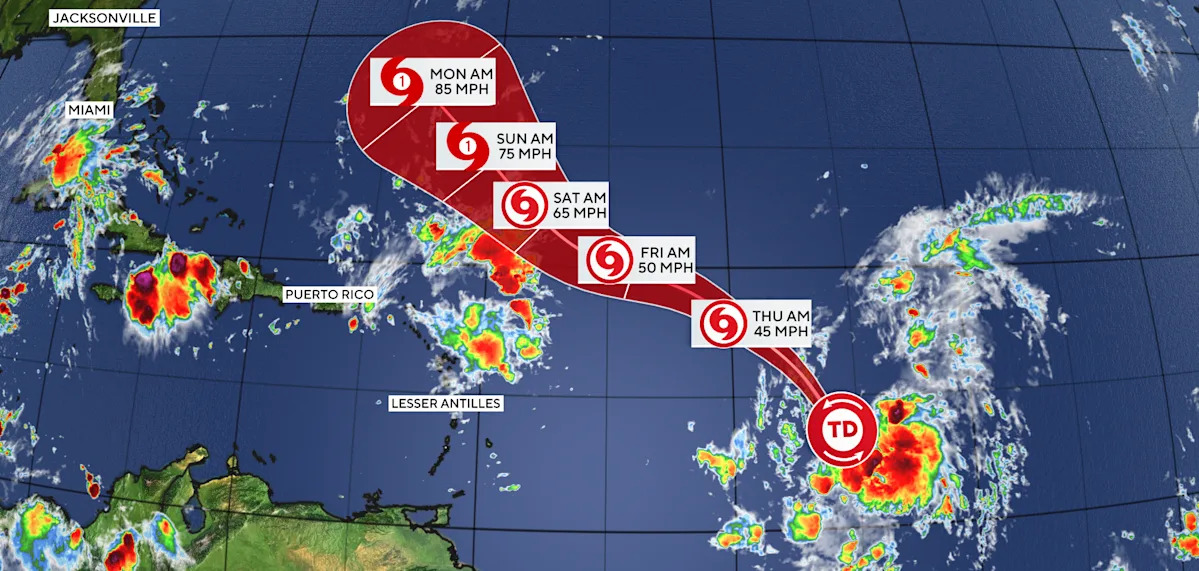
Tropical Storm Gabrielle formed Wednesday morning over the central Atlantic Ocean, becoming the seventh named storm of the 2025 Atlantic hurricane season. Forecasters expect the weather system to remain over open waters for the next several days and haven’t yet warned of any hazards that could potentially affect land. But it may become a low-grade hurricane as it intensifies over the weekend.
The storm’s current forecast predicts that Gabrielle’s track will carry it north of the Caribbean and away from land, but the system could reach Bermuda next week as it continues to strengthen, CBS News meteorologist Nikki Nolan said.
A map produced by Nolan shows Gabrielle’s anticipated westward path through Monday, at which point it may be packing hurricane-force winds as strong as 85 mph. The storm could develop into a hurricane Sunday as it passes near the Caribbean, according to the map.
CBS News meteorologist Nikki Nolan produced a map illustrating the potential path of Tropical Storm Gabrielle over the next several days. / Credit: Nikki Nolan for CBS News
Gabrielle developed before 11 a.m. ET on Wednesday, and in the evening, it was situated roughly 990 miles east of the northern Leeward Islands and tracking northwest at 22 miles per hour, the National Hurricane Center said in an advisory.
Its maximum sustained winds on Wednesday night were 50 mph, just over the threshold that differentiates a tropical depression from a tropical storm. Gabrielle grew from a tropical depression in the Atlantic that meteorologists initially flagged earlier on Wednesday.
Tropical storm force winds extended outward some 175 miles from Gabrielle’s center on Wednesday morning, the Hurricane Center said, adding that the storm’s path and overall forecast remained “highly uncertain” as its center was still poorly defined.
Another map produced by the National Hurricane Center shows Gabrielle’s potential path toward Bermuda. / Credit: National Hurricane Center
Gabrielle took shape about one week after what was historically considered the peak of the Atlantic hurricane season, which runs annually from June 1 to Nov. 30 and has in the past become most active around Sept. 10.
Officials at the National Oceanic and Atmospheric Administration initially predicted the 2025 season would be busier than usual and produce more named storms than an average year, but hurricane activity has so far been quieter than anticipated.
At the start of the season, NOAA’s outlook suggested that between 13 and 19 named storms would form in the Atlantic, with as many as nine strengthening into hurricanes and as many as five becoming Category 5 storms, which are the most powerful. The agency revised the outlook slightly in August, predicting that the season would see 13 to 18 named storms, including five to nine hurricanes, two of which could be major.
Of the six named tropical storms that have developed this year before Gabrielle, only one, Chantal, made landfall.
Cardi B exclusively opens up about pregnancy, new album and finding stability with Stefon Diggs
Robert Redford, Oscar-winning actor and director, dies at 89 | Special Report
Spirit Airlines pilots warned of proximity to Air Force One: “Pay attention”
Disclaimer: This news has been automatically collected from the source link above. Our website does not create, edit, or publish the content. All information, statements, and opinions expressed belong solely to the original publisher. We are not responsible or liable for the accuracy, reliability, or completeness of any news, nor for any statements, views, or claims made in the content. All rights remain with the respective source.
